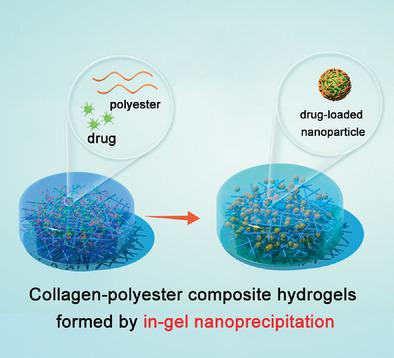Our official English website, www.x-mol.net, welcomes your
feedback! (Note: you will need to create a separate account there.)
Nanostructured Dense Collagen‐Polyester Composite Hydrogels as Amphiphilic Platforms for Drug Delivery
Advanced Science ( IF 14.3 ) Pub Date : 2021-02-18 , DOI: 10.1002/advs.202004213 Xiaolin Wang 1, 2 , Olivier Ronsin 3, 4 , Basile Gravez 5 , Nicolette Farman 5 , Tristan Baumberger 3, 4 , Frédéric Jaisser 5 , Thibaud Coradin 2 , Christophe Hélary 2
Advanced Science ( IF 14.3 ) Pub Date : 2021-02-18 , DOI: 10.1002/advs.202004213 Xiaolin Wang 1, 2 , Olivier Ronsin 3, 4 , Basile Gravez 5 , Nicolette Farman 5 , Tristan Baumberger 3, 4 , Frédéric Jaisser 5 , Thibaud Coradin 2 , Christophe Hélary 2
Affiliation

|
Associating collagen with biodegradable hydrophobic polyesters constitutes a promising method for the design of medicated biomaterials. Current collagen‐polyester composite hydrogels consisting of pre‐formed polymeric particles encapsulated within a low concentrated collagen hydrogel suffer from poor physical properties and low drug loading. Herein, an amphiphilic composite platform associating dense collagen hydrogels and up to 50 wt% polyesters with different hydrophobicity and chain length is developed. An original method of fabrication is disclosed based on in situ nanoprecipitation of polyesters impregnated in a pre‐formed 3D dense collagen network. Composites made of poly(lactic‐co‐glycolic acid) (PLGA) and poly(lactic acid) (PLA) but not polycaprolactone (PCL) exhibit improved mechanical properties compared to those of pure collagen dense hydrogels while keeping a high degree of hydration. Release kinetics of spironolactone, a lipophilic steroid used as a drug model, can be tuned over one month. No cytotoxicity of the composites is observed on fibroblasts and keratinocytes. Unlike the incorporation of pre‐formed particles, the new process allows for both improved physical properties of collagen hydrogels and controlled drug delivery. The ease of fabrication, wide range of accessible compositions, and positive preliminary safety evaluations of these collagen‐polyesters will favor their translation into clinics in wide areas such as drug delivery and tissue engineering.
中文翻译:

纳米结构致密胶原蛋白聚酯复合水凝胶作为药物输送的两亲平台
将胶原蛋白与可生物降解的疏水性聚酯结合构成了一种有前途的药用生物材料设计方法。目前的胶原蛋白-聚酯复合水凝胶由封装在低浓度胶原蛋白水凝胶内的预成型聚合物颗粒组成,其物理性能较差且载药量较低。在此,开发了一种两亲性复合平台,将致密胶原水凝胶和高达 50 wt% 的具有不同疏水性和链长的聚酯结合起来。公开了一种基于聚酯原位纳米沉淀的原始制造方法,所述聚酯浸渍在预成型的 3D 致密胶原蛋白网络中。与纯胶原致密水凝胶相比,由聚乳酸乙醇酸(PLGA) 和聚乳酸 (PLA) 但不是聚己内酯 (PCL) 制成的复合材料表现出改善的机械性能,同时保持高度水合。螺内酯(一种用作药物模型的亲脂性类固醇)的释放动力学可以在一个月内进行调整。未观察到复合材料对成纤维细胞和角质形成细胞具有细胞毒性。与预成型颗粒的掺入不同,新工艺可以改善胶原水凝胶的物理性能并控制药物输送。这些胶原蛋白聚酯易于制造、多种易获得的成分以及积极的初步安全性评估将有利于它们在药物输送和组织工程等广泛领域的临床应用。
更新日期:2021-04-08
中文翻译:

纳米结构致密胶原蛋白聚酯复合水凝胶作为药物输送的两亲平台
将胶原蛋白与可生物降解的疏水性聚酯结合构成了一种有前途的药用生物材料设计方法。目前的胶原蛋白-聚酯复合水凝胶由封装在低浓度胶原蛋白水凝胶内的预成型聚合物颗粒组成,其物理性能较差且载药量较低。在此,开发了一种两亲性复合平台,将致密胶原水凝胶和高达 50 wt% 的具有不同疏水性和链长的聚酯结合起来。公开了一种基于聚酯原位纳米沉淀的原始制造方法,所述聚酯浸渍在预成型的 3D 致密胶原蛋白网络中。与纯胶原致密水凝胶相比,由聚乳酸乙醇酸(PLGA) 和聚乳酸 (PLA) 但不是聚己内酯 (PCL) 制成的复合材料表现出改善的机械性能,同时保持高度水合。螺内酯(一种用作药物模型的亲脂性类固醇)的释放动力学可以在一个月内进行调整。未观察到复合材料对成纤维细胞和角质形成细胞具有细胞毒性。与预成型颗粒的掺入不同,新工艺可以改善胶原水凝胶的物理性能并控制药物输送。这些胶原蛋白聚酯易于制造、多种易获得的成分以及积极的初步安全性评估将有利于它们在药物输送和组织工程等广泛领域的临床应用。











































 京公网安备 11010802027423号
京公网安备 11010802027423号